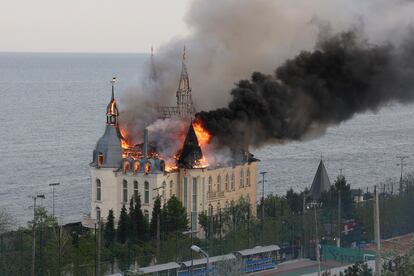Russia strikes Odesa with ballistic missiles and cluster bombs
Moscow for the first time during its invasion targeted a non-front line area with weaponry that is banned by more than 100 countries due to its lethality in civilian areas

Russia has for the first time in its war in Ukraine attacked a city far from the front lines with cluster bombs. The Odesa promenade was hit Monday by an Iskander ballistic missile carrying this multi-explosive munition. Five people were killed and more than 30 injured. The invading army on Tuesday night against struck the Ukrainian Black Sea capital with three more Iskander missiles, killing three people.
Both armies use cluster munitions, but until now they had been only been deployed in front line regions. Russian forces have previously used cluster bombs in urban areas, but these were close to the combat zones. Nine people were killed in July 2023 in the municipality of Lyman, in Donetsk province, after a Russian attack with cluster munitions. Human rights organizations including Human Rights Watch called for the bombing to be investigated as a war crime. This type of weaponry is intended to cause destruction over large areas and is more effective in open spaces. Due to its lower accuracy and higher lethality in civilian areas, since 2008 over 100 countries have signed a treaty not to use cluster munitions. However, neither Russia, Ukraine nor the United States — which has provided this weaponry to Kyiv — have added their signatures to the treaty.
Ukraine’s Prosecutor General’s Office on Tuesday released a video demonstrating Russian use of cluster munitions in downtown Odesa. “Russia cynically ignores all norms of international humanitarian law,” said Prosecutor General Andriy Kostin. The video shows the missile targeting a marina in a recreational area in the city center, indicating that the invading forces may have believed that military vessels were located at the facility. Explosive remnants were found within a one-mile radius. A landmark neo-Gothic building in Odesa, a university residence, was set ablaze during the attack.
April 29. The moment of russia attacking the peaceful city of Odesa with a CLUSTER (CASSETTE) BOMB. Barbaric.#RussianWarCrimes #StandWithUkraine pic.twitter.com/2qyO1aYOwY
— olexander scherba🇺🇦 (@olex_scherba) April 30, 2024
Initial reports of Tuesday night’s attack also pointed to a second cluster munition bombing. A video posted on social networks showed the characteristic sound of the multiple explosions caused this type of weaponry, but the Ukrainian army has not confirmed this. Illia Yevlash, spokesman for the Ukrainian Air Force, said Wednesday that the Russian objective is to provoke terror among citizens and destabilize society.
Yevlash pointed out that Odesa and Kharkiv are the two cities that have been hit the hardest this spring by the Kremlin’s troops. He also stressed that the only way to stop ballistic missiles like the Iskander is with more U.S. Patriot anti-aircraft batteries. Both municipalities have been targets of the current Russian offensive to destroy the Ukrainian power grid. A Russian bombardment on Wednesday morning in Kharkiv destroyed 10 homes, its mayor, Igor Terekhov, reported.
Defense Express, a Ukrainian military analysis media, stated that this is the first time that Russia has used Iskander missiles with cluster munitions during the invasion: “That the Russians used this material in an area where there are only civilians is because they clearly expected to cause a high number of casualties.” The precedent Defense Express cited for the use of Iskander missiles armed with cluster bombs dates to 2020, when the Armenian army, which had been a traditional ally of Russia, fired two of these missiles at Azerbaijani military positions during the Nagorno-Karabakh war.
Sign up for our weekly newsletter to get more English-language news coverage from EL PAÍS USA Edition
Tu suscripción se está usando en otro dispositivo
¿Quieres añadir otro usuario a tu suscripción?
Si continúas leyendo en este dispositivo, no se podrá leer en el otro.
FlechaTu suscripción se está usando en otro dispositivo y solo puedes acceder a EL PAÍS desde un dispositivo a la vez.
Si quieres compartir tu cuenta, cambia tu suscripción a la modalidad Premium, así podrás añadir otro usuario. Cada uno accederá con su propia cuenta de email, lo que os permitirá personalizar vuestra experiencia en EL PAÍS.
¿Tienes una suscripción de empresa? Accede aquí para contratar más cuentas.
En el caso de no saber quién está usando tu cuenta, te recomendamos cambiar tu contraseña aquí.
Si decides continuar compartiendo tu cuenta, este mensaje se mostrará en tu dispositivo y en el de la otra persona que está usando tu cuenta de forma indefinida, afectando a tu experiencia de lectura. Puedes consultar aquí los términos y condiciones de la suscripción digital.
More information
Archived In
Últimas noticias
The complicated life of Francesca Albanese: A rising figure in Italy but barred from every bank by Trump’s sanctions
Half of Scotland is in the hands of 420 property owners
Reinhard Genzel, Nobel laureate in physics: ‘One-minute videos will never give you the truth’
Pinochet’s victims grapple with José Antonio Kast’s rise in Chile
Most viewed
- Pablo Escobar’s hippos: A serious environmental problem, 40 years on
- Reinhard Genzel, Nobel laureate in physics: ‘One-minute videos will never give you the truth’
- Why we lost the habit of sleeping in two segments and how that changed our sense of time
- Charles Dubouloz, mountaineering star, retires at 36 with a farewell tour inspired by Walter Bonatti
- The Florida Keys tourist paradise is besieged by immigration agents: ‘We’ve never seen anything like this’










































